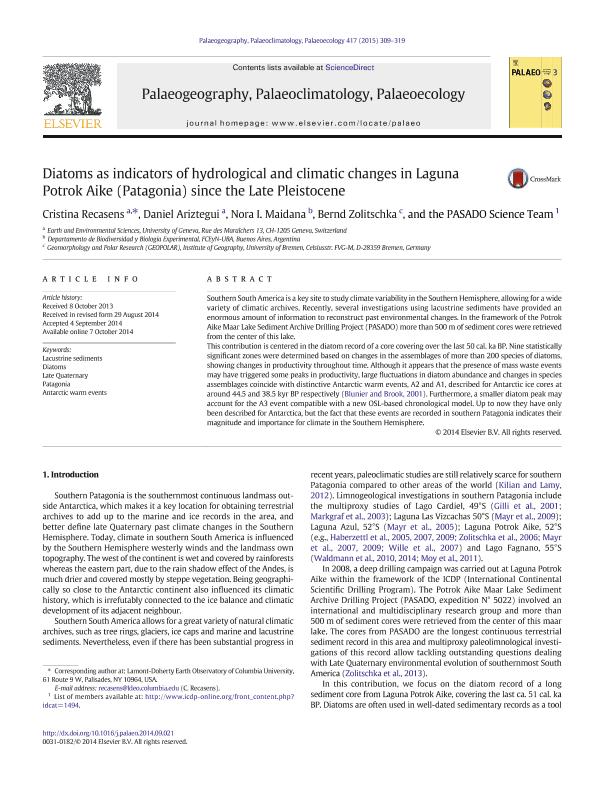Mostrar el registro sencillo del ítem
dc.contributor.author
Recasens, Cristina
dc.contributor.author
Ariztegui, Daniel

dc.contributor.author
Maidana, Nora Irene

dc.contributor.author
Zolitschka, Bernd

dc.contributor.author
PASADO Science Team
dc.date.available
2019-10-08T20:56:19Z
dc.date.issued
2015-01
dc.identifier.citation
Recasens, Cristina; Ariztegui, Daniel; Maidana, Nora Irene; Zolitschka, Bernd; PASADO Science Team; Diatoms as indicators of hydrological and climatic changes in Laguna Potrok Aike (Patagonia) since the Late Pleistocene; Elsevier Science; Palaeogeography, Palaeoclimatology, Palaeoecology; 417; 1-2015; 309-319
dc.identifier.issn
0031-0182
dc.identifier.uri
http://hdl.handle.net/11336/85388
dc.description.abstract
Southern South America is a key site to study climate variability in the Southern Hemisphere, allowing for a wide variety of climatic archives. Recently, several investigations using lacustrine sediments have provided an enormous amount of information to reconstruct past environmental changes. In the framework of the Potrok Aike Maar Lake Sediment Archive Drilling Project (PASADO) more than 500. m of sediment cores were retrieved from the center of this lake.This contribution is centered in the diatom record of a core covering over the last 50. cal. ka BP. Nine statistically significant zones were determined based on changes in the assemblages of more than 200 species of diatoms, showing changes in productivity throughout time. Although it appears that the presence of mass waste events may have triggered some peaks in productivity, large fluctuations in diatom abundance and changes in species assemblages coincide with distinctive Antarctic warm events, A2 and A1, described for Antarctic ice cores at around 44.5 and 38.5 kyr BP respectively (Blunier and Brook, 2001). Furthermore, a smaller diatom peak may account for the A3 event compatible with a new OSL-based chronological model. Up to now they have only been described for Antarctica, but the fact that these events are recorded in southern Patagonia indicates their magnitude and importance for climate in the Southern Hemisphere.
dc.format
application/pdf
dc.language.iso
eng
dc.publisher
Elsevier Science

dc.rights
info:eu-repo/semantics/openAccess
dc.rights.uri
https://creativecommons.org/licenses/by-nc-nd/2.5/ar/
dc.subject
ANTARCTIC WARM EVENTS
dc.subject
DIATOMS
dc.subject
LACUSTRINE SEDIMENTS
dc.subject
LATE QUATERNARY
dc.subject
PATAGONIA
dc.subject.classification
Oceanografía, Hidrología, Recursos Hídricos

dc.subject.classification
Ciencias de la Tierra y relacionadas con el Medio Ambiente

dc.subject.classification
CIENCIAS NATURALES Y EXACTAS

dc.subject.classification
Otros Tópicos Biológicos

dc.subject.classification
Ciencias Biológicas

dc.subject.classification
CIENCIAS NATURALES Y EXACTAS

dc.title
Diatoms as indicators of hydrological and climatic changes in Laguna Potrok Aike (Patagonia) since the Late Pleistocene
dc.type
info:eu-repo/semantics/article
dc.type
info:ar-repo/semantics/artículo
dc.type
info:eu-repo/semantics/publishedVersion
dc.date.updated
2019-10-04T18:39:28Z
dc.journal.volume
417
dc.journal.pagination
309-319
dc.journal.pais
Países Bajos

dc.journal.ciudad
Amsterdam
dc.description.fil
Fil: Recasens, Cristina. Universidad de Ginebra. Facultad de Ciencias. Sección de Ciencias de la Tierra; Suiza
dc.description.fil
Fil: Ariztegui, Daniel. Universidad de Ginebra. Facultad de Ciencias. Sección de Ciencias de la Tierra; Suiza
dc.description.fil
Fil: Maidana, Nora Irene. Universidad de Buenos Aires. Facultad de Ciencias Exactas y Naturales. Departamento de Biodiversidad y Biología Experimental; Argentina
dc.description.fil
Fil: Zolitschka, Bernd. Universitat Bremen. Institut Fuer Geographie; Alemania
dc.description.fil
Fil: PASADO Science Team. Universidad de Ginebra. Facultad de Ciencias. Sección de Ciencias de la Tierra; Suiza
dc.journal.title
Palaeogeography, Palaeoclimatology, Palaeoecology

dc.relation.alternativeid
info:eu-repo/semantics/altIdentifier/doi/http://dx.doi.org/10.1016/j.palaeo.2014.09.021
dc.relation.alternativeid
info:eu-repo/semantics/altIdentifier/url/https://www.sciencedirect.com/science/article/pii/S0031018214004763
Archivos asociados
